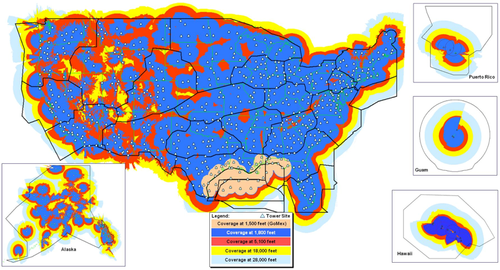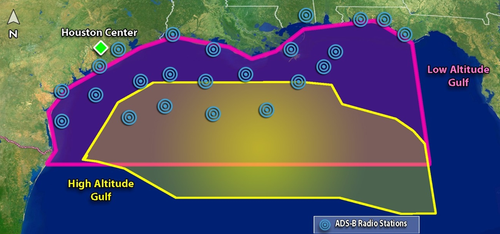Next Gen key step: ADS-B helping Houston Controllers in the Gulf
A key technology in the US Next Generation air traffic control system has been deployed to Houston and is now significantly increasing capacity and helping controllers track traffic over the Gulf of Mexico, something it could not do before, owing to the lack of radar coverage over such a wide expanse. Satellite-based Automatic Dependent Surveillance-Broadcast (ADS-B) affords more efficient and safe aircraft separation and management over the Gulf.
Tested in Anchorage, AK, beginning in 2000, the technology more than achieved its goal of affording greater situational awareness to Alaska pilots flying some of the harshest terrain on the planet. That increased awareness helped to halve the accident rate for equipped aircraft. ADS-B is expected to be available nationwide by 2013.
ADS-B tower deployment plan for 2013
After deployment in Louisville and Houston, controllers in Philadelphia will begin using ADS-B in February and the system will become operational in Juneau in April.
The capacity enhancements afforded by ADS-B allow aircraft separation at five miles rather than the 120 miles required at high altitudes when there was no radar coverage over the Gulf. The new technology will also allow the FAA to provide new, more direct routes over the Gulf of Mexico, improving the efficiency of aircraft operations while using less fuel.
ADS-B sites in the Gulf of Mexico
"This is a significant, early step toward NextGen," FAA Administrator Randy Babbitt said in a press conference at the Houston Air Route Traffic Control Center. "We're delivering on time, a system that's not only more accurate than radar but comes with significant safety and efficiency benefits. This will save time and money for aircraft operators and passengers and reduce our carbon footprint."
The new capability for the FAA has significant implication for the helicopter traffic in the region. ADS-B, which is one of the technologies at the heart of the transformation to NextGen, is transforming the Houston/Gulf region from the using estimates to actual tracking and significantly increases capacity in the region. Before ADS-B, controllers had to rely on an aircraft's estimated or reported - not actual - position. Individual helicopters flying under Instrument Flight Rule conditions at low altitudes to and from oil platforms were isolated within 20x20 mile boxes for separation. The complex, manual nature of these operations severely reduced capacity and efficiency for the 5,000 to 9,000 daily helicopter operations in the Gulf of Mexico.
Aircraft equipped with ADS-B in the region will now know where they are in relation to bad weather and receive flight information including Notice to Airmen and Temporary Flight Restrictions.
The FAA was able to install ground stations on oil platforms as part of an agreement with the Helicopter Association International, oil and natural gas companies and helicopter operators. A network of ground stations was deployed on oil platforms and the surrounding shoreline, bringing satellite-based surveillance to an area with almost as much daily air traffic as the northeast corridor.
The Gulf of Mexico is the second key site where ADS-B is being used by controllers to separate aircraft. The new technology is also being used by controllers in Louisville, KY, chosen in part because UPS voluntarily outfitted much of its fleet with ADS-B avionics. Four ground stations give controllers at the Louisville International Airport and the Louisville Terminal Radar Approach Control facility an ADS-B coverage area extending 60 nautical miles around the airport up to 10,000 feet.
The FAA first established an ADS-B prototype in Alaska, outfitting numerous general aviation aircraft with ADS-B avionics. The improved situational awareness for pilots and extended coverage for controllers resulted in a 47% drop in the fatal accident rate for equipped aircraft. In South Florida, the installation of eleven ground stations now gives pilots in equipped aircraft, free traffic and weather information. Controllers will soon begin using ADS-B in that region to separate aircraft.
This article features in the Jan-2010 edition of The Centre's global ATM management report, ATM Monthly.

